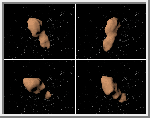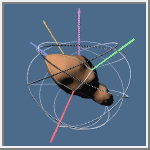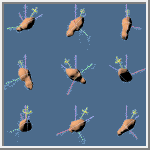 Toutatis
Toutatis Toutatis
Toutatis
In 1989, asteroid 4179 was discovered by French astronomers and named after a Celtic god that was the protector of the tribe in ancient Gaul. Its eccentric, four-year orbit extends from just inside Earth's orbit to the main asteroid belt between Mars and Jupiter. The plane of Toutatis's orbit is closer to the plane of the Earth's orbit than any known Earth-orbit-crossing asteroid.
In December 1992, Toutatis made a close approach to Earth. At the time, it was an average of about 4 million kilometers (2.5 million miles) from Earth. Images of Toutatis were acquired using radar carried out at the Goldstone Deep Space Communications Complex in California's Mojave desert. For most of the work, a 400,000-watt coded radio transmission was beamed at Toutatis from the Goldstone main 70-meter (230-foot) antenna. The echoes, which took as little as 24 seconds to travel to Toutatis and back, were received by the new 34-meter (112-foot) antenna and relayed back to the 70-meter (230-foot) station, where they were decoded and processed into images.
The images of Toutatis reveal two irregularly shaped, cratered objects about 4 and 2.5 kilometers (2.5 and 1.6 miles) in average diameter which are probably in contact with each other. These "contact binaries" may be fairly common since another one, 4769 Castalia, was observed in 1989 when it passed near the Earth. Numerous surface features on Toutatis, including a pair of half-mile-wide craters, side by side, and a series of three prominent ridges -- a type of asteroid mountain range -- are presumed to result from a complex history of impacts.
Toutatis is one of the strangest objects in the solar system, with a highly irregular shape and an extraordinarily complex "tumbling" rotation. Both its shape and rotation are thought to be the outcome of a history of violent collisions. "The vast majority of asteroids, and all the planets, spin about a single axis, like a football thrown in a perfect spiral, but Toutatis tumbles like a flubbed pass," said Dr. Scott Hudson of Washington State University. One consequence of this strange rotation is that Toutatis does not have a fixed north pole like the Earth. Instead, its north pole wanders along a curve on the asteroid about every 5.4 days. "The stars viewed from Toutatis wouldn't repeatedly follow circular paths, but would crisscross the sky, never following the same path twice," Hudson said.
"The motion of the Sun during a Toutatis year, which is about four Earth years, would be even more complex," he continued. "In fact, Toutatis doesn't have anything you could call a 'day.' Its rotation is the result of two different types of motion with periods of 5.4 and 7.3 Earth days, that combine in such a way that Toutatis's orientation with respect to the solar system never repeats."
The rotations of hundreds of asteroids have been studied with optical telescopes. The vast majority of them appear to be in simple rotation with a fixed pole and periods typically between one hour and one day, the scientists said, even though the violent collisions these objects are thought to have experienced would mean that every one of them, at some time in the past, should have been tumbling like Toutatis.
Internal friction has caused asteroids to change into simple rotational patterns in relatively brief amounts of time. However, Toutatis rotates so slowly that this "dampening" process would take much longer than the age of the solar system. This means that the rotation of Toutatis is a remarkable, well-preserved relic of the collision-related evolution of an asteroid.
On September 29, 2004, Toutatis will pass by Earth at a range of four times the distance between the Earth and the Moon, the closest approach of any known asteroid or comet between now and 2060. One consequence of the asteroid's frequent close approaches to Earth is that its trajectory more than several centuries from now cannot be predicted accurately. In fact, of all the Earth-crossing asteroids, the orbit of Toutatis is thought to be one of the most chaotic.

 Animation of Toutatis
Animation of Toutatis
 High Resolution Goldstone Images
(GIF, 139K)
High Resolution Goldstone Images
(GIF, 139K)
These are 8 of the "high resolution" Goldstone images that are
being used to produce a higher-resolution 3D model of Toutatis.
(From Ostro et al., Science 270:80-83, 1995--© Copyright 1995 by
the AAAS)
 High Resolution Image
(GIF, 83K)
High Resolution Image
(GIF, 83K)
This is a close up of one of the high-resolution images of Toutatis.
(From Ostro et al., Science 270:80-83, 1995--© Copyright 1995 by
the AAAS)
 4 Views of Toutatis
(GIF, 110K)
4 Views of Toutatis
(GIF, 110K)
This image shows four frames of asteroid Toutatis that were obtained on
December 8-10 and 13, 1992. On each day, the asteroid was in a different
orientation with respect to Earth. One large crater can be seen in the
December 9 image (upper right) that measures about 700 meters (2,300
feet) in diameter.
(Courtesy JPL/NASA)
 Computer Model of Toutatis
(GIF, 110K;
TIFF, 216K;
caption)
Computer Model of Toutatis
(GIF, 110K;
TIFF, 216K;
caption)
These images show a computer model of the Earth-orbit-crossing asteroid
Toutatis. These views of the asteroid show shallow craters, linear
ridges, and a deep topographic "neck" whose geologic origin is
not known. It may have been sculpted by impacts into a single, coherent
body, or Toutatis might actually consist of two separate objects that
came together in a gentle collision.
(Courtesy Scott Hudson, Washington State University)
 Spin State of Toutatis
(GIF, 29K;
TIFF, 294K)
Spin State of Toutatis
(GIF, 29K;
TIFF, 294K)
This image shows the shape and non-principal-axis spin state of
asteroid 4179 Toutatis rendered at a particular instant. The red, green,
and blue axes are the principal axes of inertia; the magenta axis is the
angular momentum vector; the yellow axis is the spin vector. If a
flashlamp was attached to the short axis of inertia (the red axis) and
flashed it every 15 minutes for a month, it would trace out the intricate
path indicated by the small spheres stacked end-to-end. If this process
was continued forever the path would never repeat. Toutatis's spin
state differs radically from those of the vast majority of solar system
bodies that have been studied.
(© Copyright 1995 by the AAAS)
 Spin State of Toutatis on Nine Successive Days
(GIF, 1K;
TIFF, 211K;
caption)
Spin State of Toutatis on Nine Successive Days
(GIF, 1K;
TIFF, 211K;
caption)
This image shows the non-principal-axis spin state of asteroid 4179
Toutatis at one-day intervals (from left to right, top to bottom).
The red, green, and blue axes are the principal axes of inertia; the
magenta axis is the angular momentum vector; the yellow axis is the spin
vector. Toutatis does not spin about a single axis. Instead, its spin
vector traces a curve around the asteroid's surface once every 5.41
days. During this time the object rotates once about its long axis,
and every 7.35 days, on average, the long axis precesses about the
angular momentum vector. The combination of these two motions with
different periods give Toutatis its bizarre "tumbling" rotation.
(Courtesy Scott Hudson, Washington State University)

